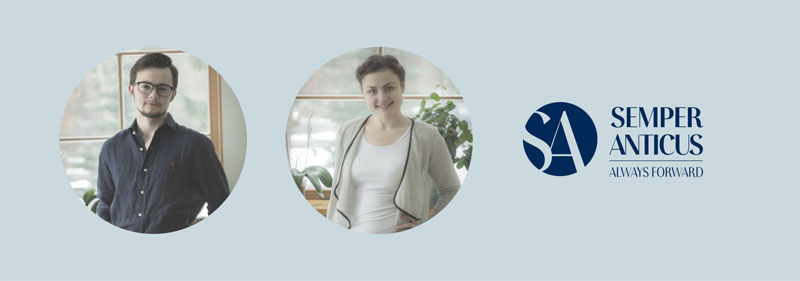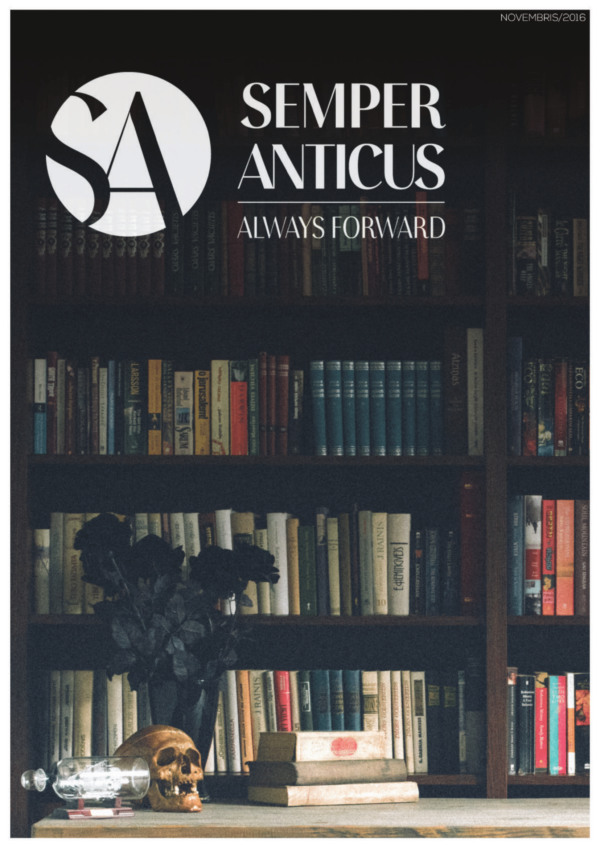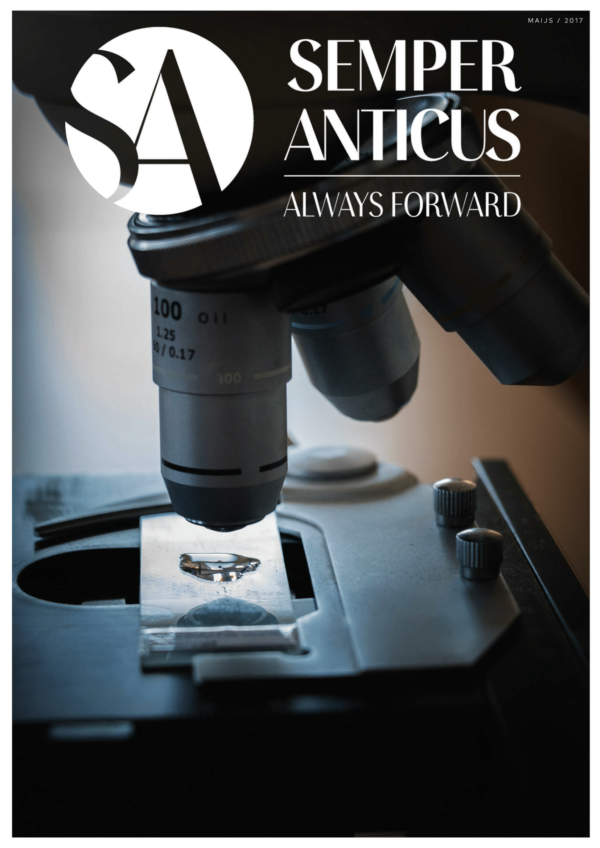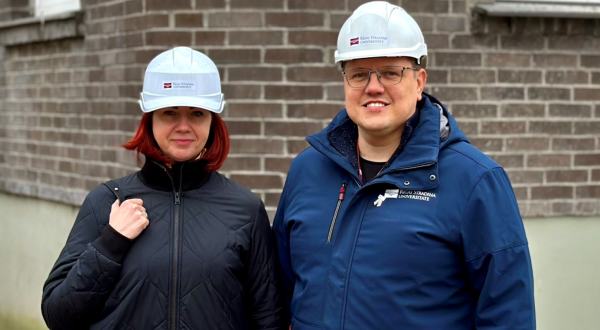Popular scientific journal for students "Semper Anticus" welcomes new ideas
Semper Anticus is a RSU Student Union-led biannual popular scientific journal devoted to social sciences, medicine and various interviews on topics of interest for students in Europe and particularly in the Baltic States. The idea behind the journal is to provide students with a forum where they can publish their scientific articles on up-to-date scientific problem issues and the latest developments in research in Latvia and globally. The first issue of Semper Anticus was released in September 2016.
Head of the Department of Communication of the Student Union Amanda Anna Bērziņa interviews Semper Anticus project managers Inga Apse and Veronika Baltmane.

How did the idea of publishing a journal originate?
The idea of a journal emerged on seeing the University of Oxford student science magazine Bang! which was brought home by the sister of one of our editors. We decided to make a student popular scientific journal which was the only one of its kind in Latvia at that time. I think that there are not many trustworthy journals in the Latvian market, as it requires access to credible sources, the ability and time for analysis which may become a stumbling block in any field. We are inspired by our families and society. The family gives support and motivates one to move forward, society acts as a link and makes us become responsible. It is important for a journal to have a certain perspective that is based on its goals, and to have a larger goal which forms the basis of the journal’s personality.
What are the origins of the name Semper Anticus?
Ivars Veckalns, one of the project managers, came up with the name Semper Anticus, a Latin phrase meaning ‘always forward’. Although historically this was the slogan of the 45th infantry division of the US army from 1920 to 1968, we are equally determined to meet the goals set by Semper Anticus.

Does the publishing of a journal require some specific personal traits or can anyone do it?
I am inclined to think that anyone could do this, but it is not true. For certain ideas to materialise, there is a need for a congruence of particular events and circumstances. You need strong motivation not to stop, because as soon as the idea materialises and the targets grow more ambitious, the walls to be scaled also grow higher and wider. It is a key factor to recruit the best team you can. I can say it with certainty – we have it!
What are the largest obstacles and hardships you have to face?
Money. Publishing a journal definitely is not a way to earn money, but rather a resource allowing the mind to meet paper. Thus, I have to admit that we at Semper Anticus, being subjective realists, have not faced any major difficulties. Yes, we have had minor ones and people who are part of the journal have learned to act and solve issues in an increasingly effective way.
What steps have to be taken to get from an idea to the finished product?
We do not stick to any pre-defined guidelines regarding the correct way to publish a journal and therefore we don’t have a standard checklist to create a tangible product. Certainly there are principles we observe, however mostly we adapt to the situation at the time. Saying that “YOU” must understand your goal and the message you would like to convey with the journal would be the right way of doing things, however I would not be telling the truth in our case. The community that is slowly forming around our team, the blog and the journal, defines our direction; at the same time we try to stick to the small ideas that we had from the outset. By and large, the team, the designer and the authors are the ones to set the tone of Semper Anticus. It is important for every editorial board to understand that without the authors and a reward-based approach the journal will soon disappear, along with its reputation.
How do you find the right people and build a team?
The expectations for accepting new people on the team have grown considerably and are more strict, compared to when we started, however it does not change the fact that building a team was difficult before stricter requirements were introduced and it still is today. In 2016 when our idea became reality, our illusions lagged heavily behind real life – even a team of six was not sufficient to release the first publication. Thus, I have to admit that we have become more demanding when selecting our team members. I have to say that the first people on our team was the best combination and it remains so! People come and go, but the core team that stood behind our first issue now forms a structured management team for setting future directions.

What are the daily tasks of the team?
"Daily" is an antonym for how we work. The only “daily” issues we face are: e-mails, public relations and finances. You see, some professions have a regular and uninterrupted workload or so-called office work. Although, in a sense, we do work in an office, every word, combination of words that we send to the printing house Dārdedze was the result of different people doing a variety of things each in their respective area to arrive at the result that we are satisfied with. A large share of the work is done by our authors, which is not a common thing in editorial offices. Many journals engage guest authors – our editorial work is mostly based on the input from guest authors, with our own writing just a small part of it, rather we help authors to craft, in our minds, the best format for their articles.
Are there any vacancies open and what are the options for students?
Semper Anticus always welcomes fresh ideas. Work is constant when it comes to new articles for our blog, led by Gerhards Reinholds Miķelsons. We will also not decline assistance in the editorial office and in the organisational sphere.
Why should students get involved and assist in creating the journal?
Creating the journal? I think it has already been created – in the improvement would be more precise! ‘Work together’ could be the key words. As a journal we have taken a linear course of development both in quality and popularity, hoping that in the future it could gain national recognition and beyond. Working in the editorial office, students don’t merely have to deal with sentences but also science, which is paramount for every student at a university!
How to attract the attention and support of the public?
There are many possibilities! Initially we made a mistake by offering advertising to companies operating in a narrow field, which certainly helped the journal to some extent but was not sufficient to guarantee the viability of the next publication. You can get public attention by defining the direction of a journal based on public demand and our vision, in this way increasing readership. Certainly there is still much to do in the area of public relations, where we are becoming more active users of social networks, such as Facebook and Instagram.
What are your aims for the future?
Universities in Latvia, the Baltic region, Europe etc. Currently I think that positioning ourselves as the best popular science journal for students would be a truly high achievement. And certainly the increase of our fixed capital!
How has the journal contributed to your personal development? What have you learnt since the first publication?
If we consider that none of us had any previous experience in publishing a journal or publishing any articles, I can certainly maintain that I have learnt from all of it. From building a team from scratch, understanding the duties, planning cost strategy etc.
What does a student gain from publishing an article in your journal? Why should a student choose to publish his work in Semper Anticus?
A publication in Semper Anticus is the same as a publication in any other popular and scientific journal. The question is about recognition – people evaluate the importance of a publication based on the public reputation of the journal in which it was published. I can assert that the contents of the journal do not lie and not a single assertion is fictitious with the exception of cases when it is meant to be. What I am trying to say is that the reputation of a student with an article published in our journal will only grow and so will the popularity of their articles.
Related news
 RSU is growing and developing: major reconstruction underway in the main buildingDevelopment, For RSU Employees, For Students
RSU is growing and developing: major reconstruction underway in the main buildingDevelopment, For RSU Employees, For Students


